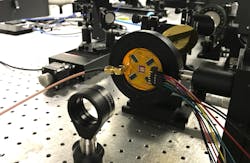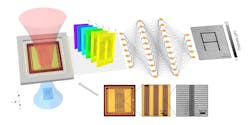Terahertz focal-plane array enables real-time, super-resolution imaging
A team of researchers led by University of California, Los Angeles (UCLA) Professors Mona Jarrahi and Aydogan Ozcan recently developed a plasmonic photoconductive terahertz focal-plane array (THz-FPA) to simultaneously tackle a long-standing imaging speed problem and provide rich, high-quality terahertz information (see video).
Terahertz time-domain imaging, which uses time-gated ultrafast laser pulses to generate and detect terahertz waves, is an extremely promising technique. After signal processing, researchers can obtain rich terahertz information, such as magnitude and phase information, ultrafast temporal information at the sub-picosecond scale, and very broadband spectral information.
Conventional terahertz time-domain imaging systems are usually built with a single-pixel terahertz detector. To acquire a terahertz image, researchers need to mechanically scan either the imaged object or the imaging system. This raster scanning process is very time-consuming and, for large objects, the total imaging time can require several hours and isn’t practical for many applications.
So, the terahertz research community has pursued a high-speed terahertz time-domain imaging system for many years.
One big obstacle preventing scaling conventional terahertz photoconductive antennas into two-dimensional (2D) arrays is their low optical fill factor, which directly impacts the terahertz detection efficiency.
To solve this problem, the researchers turned to a THz-FPA with a distributed architecture of plasmonic nanoantennas with a much higher optical fill factor. “In total, 0.3 million plasmonic nanoantennas have been integrated onto a single chip,” says Jarrahi. “Plasmonic nanoantennas are designed to enhance the interaction between the photocarriers and terahertz waves—and can achieve very sensitive terahertz detection within each pixel.”
Based on this THz-FPA, they built a terahertz time-domain imaging system that requires no mechanical raster scanning components. Its imaging process is akin to taking a picture using a cellphone camera: after one snapshot, a terahertz image is ready.
To showcase the imaging speed, the team recorded a terahertz video of flowing water passing through microfluidic channels. It’s the first known terahertz video demonstrated in a terahertz time-domain imaging system.
Not your average image
The images acquired from the team’s THz-FPA contain spatial distribution of magnitude and phase information, ultrafast temporal information, and broadband spectral information.
This multidimensional information enabled the team to demonstrate terahertz super-resolution imaging via a deep-learning convolutional neural network. When an object is illuminated with broadband radiation and multidimensional data is collected, especially spectral magnitude and phase data, it’s possible to resolve an “unresolvable” feature with the help of a convolutional neural network.
“We demonstrated the first proof-of-concept experiment by super-resolving etched patterns in silicon substrates and achieved a total effective number of pixels larger than 1-kilo pixels,” says Jarrahi. “Small details of the 2D shape can be seen, and the depth of the imaged object can be resolved as well.”
Game-changer for numerous applications
The team’s THz-FPA imaging system can be useful for many nondestructive inspection applications ranging from energy and automotive to food and pharmaceutical industries.
One application is real-time quality control of lithium-ion batteries. Lithium-ion batteries are ubiquitous in all kinds of products, including electric vehicles, smartphones, and laptops. These batteries are assemblies of different functional layers, including anode and cathode electrodes. Any defects within these layers can diminish the battery performance and cause safety hazards like fires and explosions. The team has already successfully identified various types of hidden defects within battery electrodes using their terahertz imaging system.
To date, no other nondestructive testing methods can extract the volumetric information of electrode layers and identify the structural defects in real time. In the future, the researchers expect to install the THz-FPA imaging systems into roll-to-roll production lines to further enhance battery production efficiency, safety, and performance.
FURTHER READING
X. Li et al., Nat. Photon. (2024); https://doi.org/10.1038/s41566-023-01346-2.

Sally Cole Johnson | Editor in Chief
Sally Cole Johnson, Laser Focus World’s editor in chief, is a science and technology journalist who specializes in physics and semiconductors.

